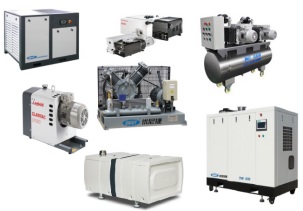hospital
- The history of human acquisition of vacuum can be traced back to the 6th century BC. The blast system of smelting furnaces and alchemy furnaces utilizes negative pressure suction and pressurized exhaust. Oil free compressors, high-pressure machines, Laibao vacuum pumps, dry screw vacuum pumps, rotary vane vacuum pumps, and screw air compressors are increasingly being used in hospitals. At the same time, the Chinese were also the first ethnic group to use medical vacuum systems. In the Western Han Dynasty, there were records of the "Jiao method" for treatment, commonly known as the "cupping jar", which fully utilized the expansion and contraction of air and steam condensation to form a vacuum for treatment.

- Some hospitals have built high-pressure rooms where patients can breathe high-pressure air or oxygen. Hyperbaric therapy is often used when patients' tissues or blood require higher than normal concentrations of oxygen. It can effectively treat carbon monoxide poisoning and respiratory disorders, and is also promising in combination with surgical procedures. The use of decompression technology is similar to its use in deep-sea diving.
- 一些医院建了高压室,以供病人在里面呼吸高压空气或氧气。高压疗法常常在病人的组织或血液需要高于正常浓度的氧气时使用,它能有效治疗一氧化碳中毒和呼吸紊乱,而且在与外科手术的结合上也很有希望。减压技术的使用类似于其用于深海潜水中。
- For inhalation therapy, clean and dry air is supplied with positive pressure from a few inches of water to a respirator in an unpressurized treatment room. Usually, oil-free compressors are used to provide compressed air for hospitals.
- 对于吸入性治疗,洁净干燥的空气由几英寸的水提供正向压力至无加压治疗室的呼吸器中。通常用无油压缩机为医院提供压缩空气。
- In an optional system that provides breathing air (which patients can easily use in hospitals or at home), oxygen rich air is removed from the atmosphere through a molecular sieve filter. Through this oxygen concentration process, the oxygen concentration can reach 90% to 95%.
- 在提供呼吸用空气的可选择系统(病人可以方便的在医院或在家使用)中,含氧丰富的空气通过一个分子筛过滤器,将大气中的氮气去除,经过这种氧气浓缩过程,氧气浓度可以达到90%至95%。
- The pneumatic surgical drill driven by high-speed turbines has an exciting ability. In cranial surgery, it can shorten the time for surgeons to remove the skull to two minutes, while using hand tools takes half an hour. It can also be used to cut open and transplant thoracic cartilage to form a simulated artificial ear, as well as shape graft bones to reconstruct a severely damaged nose. Pneumatic drills are very light, but they increase the speed and power of bone cutting, drilling, and shaping. Compressed air or nitrogen that provides power is discharged at the tip of the drill to cool the cutting area.
- 高速涡轮驱动的气动外科手术钻拥有让人兴奋的能力。在颅腔手术中,它可以令外科医生移除头盖骨的时间缩短至两分钟,而使用手工工具需要半个小时。它还可以用于切开移植的胸腔软骨形成仿真人造耳朵,以及塑造嫁接骨来重造一个严重损坏的鼻子。气动钻很轻,却提高了切骨、钻孔和塑型的速度和功率。提供动力的压缩空气或氮气在钻的尖端排出,以冷却切割区域。
- The device that controls the air conditioning and humidity in the hospital operating room is driven by compressed air. Nurses use compressed air to clean catheters and other catheters, as well as spray medication. Vacuum is used to remove blood stains and secretions during the surgical process when neither the insert nor sponge toilet can provide a clean surgical environment for the surgeon. The operating room is pressurized to remove dust. The pneumatic door of the operating room is operated by a foot pedal. Hospital laboratories, laundry rooms, and other maintenance departments also use compressed air in many ways.
- 控制医院手术室的空气调节和湿度的装置是压缩空气驱动的。护士们用压缩空气来清洁导尿管和其它导管,以及喷洒药剂。当嵌子或海绵盥洗都不能为外科医生提供一个洁净的手术环境时,真空用于清除手术过程中的血迹和分泌物。手术室是以加压方式来清除灰尘。手术室的气动门是由脚踏板操纵的。医院实验室、洗衣室、和其它维护部门也在许多方面使用压缩空气。

